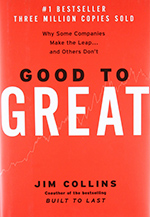Good to Great:
Why Some Companies Make the LEAP… and Others Don’t
| Author: Jim Collins, 2001 |
You know that great feeling when you go back to something and you forgot how awesome it really was? That was what it was like going back to this memorable, eye-opening study on leadership, business, and results, which I first read when it was given to me by my management team in 2001
In Good to Great, Jim Collins has created a timeless classic. Through an in-depth study of 1,435 companies, he found 11 that stood out to meet the final criteria—and shows a valuable lesson about the important of having the right people and the right leadership in an organization.
In his book, Collins breaks things down into five main topics.
Topic #1: Level 5 Leadership
Everything ties back to mindset. The leaders that attribute their success to luck and their setbacks to their actions are in the exact opposite situation as leaders who take credit for success and blame outside circumstances when things do not go well.
To show the qualities of a Level 5 leader, Collins uses a memorable analogy about mirrors and windows. When things are not going well, Level 5 Leaders look in the mirror and reflect. When things are going well, they look out the window to all the members that drove the success. They are more focused on what they build, not what they get out of it.
Topic #2: The Hedgehog Concept
When I started my business, I felt more like a fox trying different things. But that’s okay—research shows it takes about four years to really figure it out. My focus is in manufacturing and the construction, logistics, and operations space. The expertise allows me to wander outside of manufacturing, though I like to keep that to less than 30 percent.
That is the epiphany of taking a complex goal and simplifying it to a relentless focus. I have been around in manufacturing and it is difficult to find companies that are consistent in their performance culture. Things get so busy and we find excuses.
Collin’s book presents three main questions on this topic:
- What can you be the best at in the world—and what aren’t you the best at?
- What drives your economic engine?
- What are you deeply passionate about?
Topic #3: Culture of Discipline
When coaching a manufacturing plant client recently, I asked the open-ended questions about his thoughts on creating more rules or tighter expectations. We talked about guardrails, how tight they needed to be, and the advantages and disadvantages of using those guardrails. Eventually, we got to the “a-ha!” moment of realizing tight guardrails may actually create a more disciplined system and decrease the culture of discipline.
In Great to Good, Collins shows a distinct pattern: successful companies build consistent systems with clear constraints, but also gave people freedom and responsibility within the framework of that system.
Topic #4: Technology Accelerators
While all “good to great” companies had access to the technology, Collins’ research shows that success depends on the application of carefully selected technologies, rather than the technology itself.
It reminded me of a topic Simon Sinek shared about a discussion with an executive at Apple, regarding the release of their competition to the iPad. Even though the executive knew that Microsoft would be doing great things, they stuck to their hedgehog approach and never shifted in response to the actions of Microsoft and others.
Topic #5: The Flywheel
Companies don’t make the transformation from good to great in one fell swoop. It takes effort to get it going, but if you keep pushing, it gets momentum, things get a little easier. And then eventually, it takes off.
What I find most interesting about this point in Collins’ book is the discipline it takes to focus on the long-term goals and keep faith in trusting the buildup-breakthrough flywheel model despite outside noise, pressures, and shiny objects!
My personal reflection takes me back to running the core production department of a manufacturing plant. We were making good money and had lots of business, but people were not happy. This is because we got a little lazy and stopped working hard enough to turn the flywheel. When a different leader stepped in and got everyone refocused, we started getting much better rates. As Collins describes, people want to be part of a winning team. When we started winning, everyone was happy because they were part of that force of momentum on the flywheel.
Favorite Quote
“The purpose of bureaucracy is to compensate for incompetence and lack of discipline.”
I think this quote ties in very well with Point #3 about creating a culture of discipline, and the important of analyzing when and how guardrails are being used, and if they’re really helpful to discipline.
Biggest Takeaway
It doesn’t matter what your core values are. What matters is that you have them and that you build off them. Preserve those core values and stimulate progress. Keep to your “why,” but know that sometimes you must shift your “what” and “how” to keep up with the times. Try things, adjust with time, and figure out where to pivot, all without losing the foundations that got you there.
Reviewed by: Trevor Blondeel, June 25, 2019

